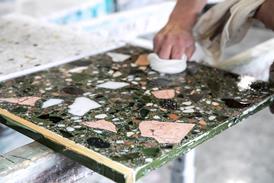This is The Lowry, the first in a series of public buildings which Salford’s planners hope will revitalise the otherwise desolate docklands. Build a major cultural centre in the middle of dereliction, runs the argument, and offices, homes and light industry are sure to agglomerate.
While The Lowry doesn’t exactly resemble the eponymous painter’s fond images of ordinary people weaving their lives among the drab mills and tenements of a largely vanished industrial Manchester, the building can certainly be said to fit its dockland surroundings. Consulting engineer Buro Happold visualised the publicly funded £60 million project as “the prow of a ship surging from the quayside”.
To the lay observer though, The Lowry will probably appear more a futuristic jumble of rectangles, tubes and hemispheres. These were arranged by architect Michael Walford & Partners to house a cornucopia of theatres, galleries, shops and bars, along with a gallery dedicated to L S Lowry’s work.
The resulting five-storey 22 000 m2 complex is truly labyrinthine, with a promenade snaking around the outside of the arts spaces. As Buro Happold’s David Hull described the building’s struggling mosaic of alloy and glass: “if there’s a right angle, it’s a mistake.”
With its kaleidoscopic colours and oddly-shaped spaces, ‘vivid’ is an inadequate word to convey the building’s energy. The promenade leads visitors through the story of the centre. The swirling walk involves changes in level and opens up a veritable artistic experience, taking visitors along the edge of the Lowry Galleries and the madcap Artworks space: a ‘hands-on’ area where visitors can explore their own creativity.
A 1700 person theatre, the Lyric, has balconies just 12·5 m away from the stage. Theatre Project Consultants, who helped on the designs, used a computer model to plot vision lines. This simulated the view of the stage from every seat in the auditorium (see opposite).
Ventilation design
The theatres are served by low velocity displacement ventilation – 2-2·5 m/s for supply, 3-3·5 m/s for extract. Variable volume supply air is injected though diffusers beneath the seats.
Ventilation to the galleries and associated spaces is treated by carbon filters, primarily to remove SO2. The only evidence of ventilation is the 40 mm thick protrusion of a linear diffuser 5 m above floor level. This runs continuously around the galleries for consistency of appearance.
The viewing areas are designed to provide 2261°C, with 5065% rh with consistent vertical conditions in painting areas. As David Hull put it: “The Laughing Cavalier’s head mustn’t be cooler than his feet.” The air is subsequently extracted at low level through slim diffusers near the bottom of the walls.
Partitions separate the picture viewing areas from circulation spaces and divide the paintings from the glazed north-facing facade – effectively, a buffer zone between the close control gallery and external conditions.
Canal cooling
The total cooling load for The Lowry is estimated at 1600 kW – surprisingly low by a reflection of the building’s diversity of occupation.
The designers have taken advantage of the Manchester Ship Canal by using the water for cooling the condensers for the R147c chillers. Buro Happold calculated that this bumps up coefficients of performance from the usual 2·5-3 to between 6 and 8.
The engineers were fortunate that accurate records of water temperature were available – the city council is trying to improve water quality and had commissioned a study of the canals. They were thus armed with the knowledge that water temperatures vary from 6-24°C during the May to November cooling season, and that the water level is very stable.
Even though the canal water is extracted 1.5 m below the surface, specifically to avoid both floating wood and silt, the engineers took care to filter it twice before the heat exchangers.
Lighting for the arts
The building uses many different light sources, although daylight also figures strongly. Damaging ultra-violet light and high lux-levels, have been avoided by daylight linked electric lighting working in tandem with external louvres.
North-facing roof lights 5·5 m above the floor sport motorised blinds to prevent excessive daylight from penetrating the building. Between 50-350 lux of light are provided for the gallery spaces, with no more than 50 lux of daylight falling on paintings themselves. The perimeter windows surrounding the galleries are prevented from throwing direct light into the viewing space by external louvres, and the perimeter wall stifles the risk of uneven lighting that windows could have caused (figure 1).
Vertical shading on the north facade cuts out early morning or late evening sun. The Artworks Gallery, in contrast, wears horizontal louvres to reduce the more continuous solar gains from the south.
Lighting control is enormously complex: some areas are controlled by the building energy management system, while others, like administrative offices, have local switching. The theatres are controlled independently.
The Lowry was receiving plaudits before even opening. It was awarded top prize at the Celebrating Construction Achievement awards on 5 April, with judges selecting it as the best millennium project. Its questionable whether the modest L S Lowry would approve of the latest home for his life’s work, but for visitors The Lowry will certainly be a memorable experience, whether or not they appreciate the art.
Downloads
Figure 1: Section taken through The Lowry Gallery
Other, Size 0 kb
Source
Building Sustainable Design
Postscript
The Lowry opens on 28 April 2000. For the dates and booking details of the theatre and ballet productions, contact the booking office on 0161 876 2000.




















